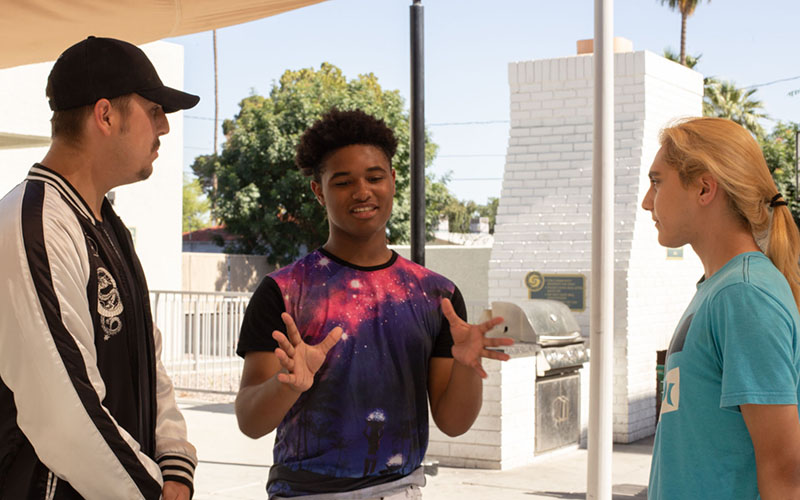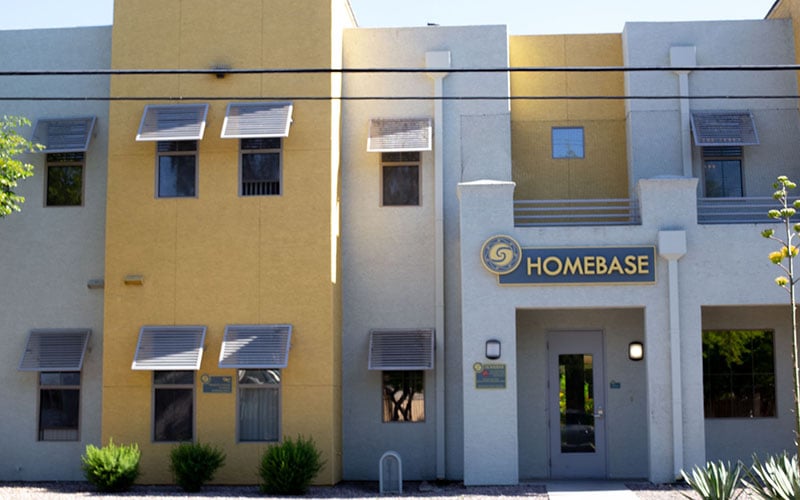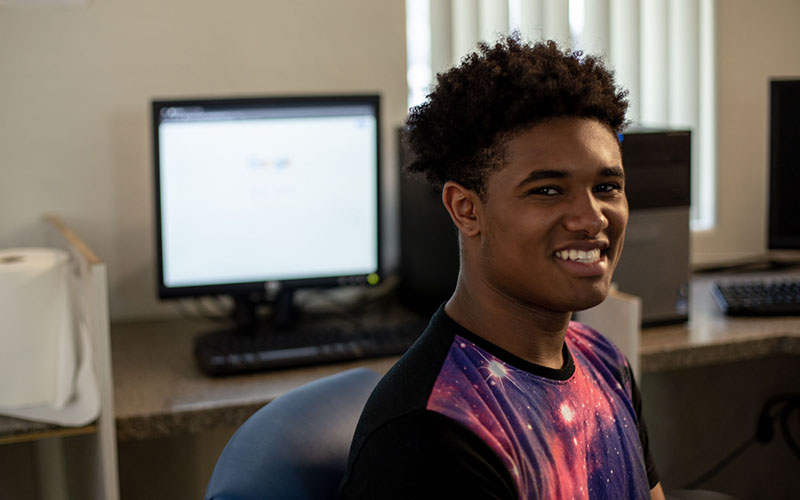PHOENIX – Clay Hollinshed found himself sleeping under the stars in a community park near Grand Canyon University in west Phoenix this past winter. But he wasn’t afraid.
“I felt free,” he said, beaming ear to ear, his curly hair peeking out from inside the white bandana attempting to hold it in place.
He had gathered his few belongings and left the group home where he had been living since 2016, tired of the chaos that surrounds the foster care system. He had just turned 18, had no place to go and no ties to his family.
Hollinshed sounds mature but, in a Mickey Mouse T-shirt, looks innocent. The freedom he experienced under the stars now is limited to the walls of an emergency housing program for homeless youth called HomeBase, where he has been living about six months.
That night in the park was Hollinshed’s only night on the streets. He crashed with an ex-boyfriend for a couple of weeks after that, sleeping in the boyfriend’s room at a nonprofit shelter for homeless LGBTQ youth. It was far from a permanent solution. There was no room for him. The place was already full.
A social worker there found him a spot at HomeBase. Hollinshed now is back in high school repeating his junior year, which was disrupted when finding a place to stay became his overwhelming priority.
He’s averaging B’s in all of his classes and is adjusting well to his new environment. He doesn’t know where he would be without HomeBase.
“I don’t think I would be on track like I am,” he said.
Thousands like him
According to the 2018 Annual Homeless Assessment Report, conducted by the federal Department of Housing and Urban Development, roughly 553,000 people experienced homelessness on a single night in the United States. Of those, about 36,000 were ages 18 to 25 and, as such, they belong in a special category known as unaccompanied homeless youth, which has its own challenges and needs. In Maricopa County, the most recent homeless count registered 377 unaccompanied youth on the streets or in housing programs on a given day.
Brande Mead, the human services director at the Maricopa Association of Governments, said the results for this year’s count, conducted in January, will be available soon. Mead cautioned, though, that the number of homeless people has been increasing for the past four or five years — a trend that’s expected to continue.
“We do have a regional plan to end homelessness,” she said in an interview. “Each year, we look to recommend funding for new programs to create additional permanent supportive housing opportunities.”
Still, the problem seems far from being solved.
HomeBase is one of 18 programs operated by Native American Connections, a group of organizations whose original mission was to help the Native American population in Arizona. HomeBase is open to people of all races and ethnicities. Its goal is to get young people off the streets and away from homeless adults, who might prey on them or drag them into a life of drug and alcohol addiction.

Clay Hollinshed, 18, uses one of the two computers at HomeBase to finish his homework. There is also an exercise room residents can use when they’ve finished mandatory chores. (Photo by Lindsay Walker/Cronkite News)
P.J. Jasso, the director of public engagement for Native American Connections, said homeless youth are particularly vulnerable. She recalled a young man who used to hang around the Central Arizona Shelter Services building, the main homeless shelter in downtown Phoenix, but also spent time at HomeBase, even though he wasn’t a resident there because there was no room for him. One day, the young man stopped coming — and the next time the staff at HomeBase him, something had changed, Jasso said.
“You could see a deterioration,” said Jasso. The young man never returned to HomeBase, she said.
Dawn Shires, who worked with the adult homeless population in Phoenix for 10 years before coming to HomeBase a year ago, put it this way: “The hope tends to be a little more alive in the youth.”
The HomeBase shelter is a stone’s throw from the Veterans Affairs hospital in Phoenix, in a building that looks like a cross between an apartment complex and a college dorm, with its gray stucco walls and wrought-iron fencing. The organization’s name is spelled out in modern gold lettering on the wall facing the street. If you don’t already know it is an emergency shelter, you might even mistake it for one of the apartment buildings that have cropped up nearby.
There is a large courtyard in the middle, where residents gather to talk, laugh and smoke when they’re not in school or at work. Hollinshed and his friends like to sit here when they aren’t doing mandatory chores, such as washing dishes or cleaning equipment in the exercise room.
“They won’t let me smoke,” he said of his friends, a touch of resentment seeping through his ever-present smile. “They always call me a baby.”
Shelter, structure, stability
The shelter has 25 beds for young men and women ages 18 to 24; in March, eight of these beds were set aside for women. Residents usually are allowed to stay 30 to 60 days. There’s another shelter just like it under construction around the corner.
While at HomeBase, residents are required to adhere to a strict, structured schedule — in some cases, at least, the first hint of structure they have experienced in years. They wake up at 7 a.m., have breakfast at 8 and attend their first life-skills class of the day at 9 a.m.; a second class runs from 2-4 p.m. Saturdays also include either a toastmasters session, where residents practice their public-speaking skills, or financial literacy, with volunteers from Bank of America.
Only those who work or have homework to do are allowed to miss this life-skills class. Residents have free time after dinner, when they can work out or use the computer before curfew at 10 p.m. sharp. The staff member on duty at dinnertime will read announcements from a clipboard and chastise the residents for using their phones — not unlike a counselor at a summer camp.
It’s a far cry from the disorder they experienced on the streets.
Hollinshed grew up in a strict military family, so the structure HomeBase demands doesn’t bother him the way that it does some other residents.
“I guess you could say it’s comforting,” he said.

HomeBase looks like almost any central Phoenix apartment complex, but it’s an emergency shelter for homeless youth. Most residents are limited to 30- to 60-day stay at the transitional shelter. (Photo by Lindsay Walker/Cronkite News)
He says he has no relationship with his parents and siblings these days. He channels that heartbreak into strength.
“I don’t want to turn out to be like a failure or whatever,” he said, with a sad smile, of his parents’ low expectations for him. “So getting good grades in school and attempting to do something with my life is better.”
The life-skills classes are meant to build self-esteem. They include a mixture of stretching and meditation, journaling and even movie analysis to help the residents open up about the trauma they carry around with them.
“When you’re homeless, you’re just holding your breath until you feel safe,” Shires said. As education, employment and life-skills specialist, Shires runs the life-skills program at HomeBase.
Shires — thick black hair, thick black eyeliner and thick New York accent — has become a mother of sorts to long-term residents at HomeBase. They often pop into her stuffed-animal-filled office, just off the courtyard, to chat. They seem to crave the stability that she represents.
“A lot of them don’t have family, so they think of the staff as their family,” said Michael Lafitte, the property manager.
‘The youth get overlooked’
Lafitte has been with HomeBase for more than 16 years. He handles the intake of residents and evaluates their levels of vulnerability, which determines who goes on the wait list and who gets a bed first. Lafitte said the average wait time for an open bed is about two weeks.
When homeless youth come to the shelter, the first thing they do is fill out a form to assess their needs. The form, which can be accessed by other shelters and homeless-service providers in metro Phoenix, asks pointed questions, such as “Have you ever traded sex for a place to stay?” If there’s a spot available and the youth is deemed to have a high level of vulnerability, he or she can move in that day. If not, one of two on-site case managers will try to help them find other options.
Homeless programs in Phoenix are extremely integrated, Shires said.
It took two weeks for a bed to become available for Hollinshed. Sarah Kent, a case manager who works for One n Ten, the shelter for LGBTQ youth where Hollinshed’s ex-boyfriend put him up for a couple of weeks, was instrumental in helping him secure it.
The challenges Hollinshed faced are typical of most homeless youth, especially those who are gay.
“I often find commonalities such as family abandonment, family abuse in the home. They will most often have some experience with DCS (Department of Child Safety) or group homes, things like that,” Kent said, referring to the state’s child welfare agency. “They differ in that, not only do they come from a family environment that is maybe unhealthy or unsafe, but then they also get that same discrimination at school or other places.”

Clay Hollinshed talks with two friends in the HomeBase courtyard. Residents have a strict schedule at the shelter, including life-skills classes to build self-confidence and teach such lessons as financial literacy. (Photo by Lindsay Walker/Cronkite News)
Kent says safety is key for these homeless youth. But there is another problem: the lack of money.
In March 2018, HomeBase, like many other transitional shelters across the country, lost the funding they received from the federal government, which took issue with the term “transitional.” HomeBase, where residents had previously stayed three to six months, was reclassified when it limited stays to the current 60-day maximum. Its funding is now contingent on its status as temporary, emergency housing. HomeBase has made an exception for Hollinshed, who has needed more time in the stable housing the organization provides while he gets adjusted to his new high school.
Jasso says the organization stays afloat through government funding, grant money and donations. Starbucks regularly gives day-old pastries so residents can have treats, and Einstein Bros. Bagels occasionally drops off bagels. HomeBase also runs a “Chef for the Night” program, where different philanthropic groups cook dinner for the residents.
Lafitte says, however, that a lot more money and resources are needed to help this vulnerable population.
“The youth get overlooked,” Lafitte said. “They haven’t been homeless for long, and many grants are set up for veterans. They don’t see youth as an issue.”
At 18, Hollinshed is the youngest resident at HomeBase. Although he’s lived at the shelter for six months, staff members are hesitant to discuss moving him into his own apartment and would rather he continues to adjust to his new school and living situation.
That’s more than fine with Hollinshed. He’s never lived alone before.
“I’m a little scared,” he said, twisting his curls between his fingers, a nervous tic of his.
Once the school year ends in May, though, he might have to get used to the idea of being completely on his own, because HomeBase will need his spot for another vulnerable youth. He recently applied for a job at Starbucks to start saving up for his new place.
Hollinshed thinks he’s come a long way since first arriving at HomeBase earlier this year.
“I just needed a place to sleep,” he said. “It started out as that. But now I want to finish school, I want to go to college.”

